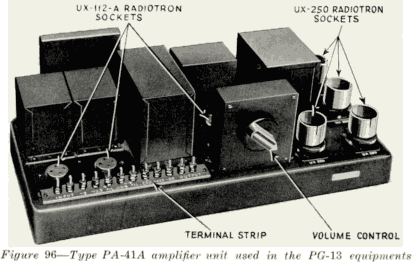143. Replacement of Vacuum Tubes.-Vacuum tubes, like many other types of apparatus, do not have an
indefinite life, but need to be replaced occasionally if the amplifier equipment is to give its best
performance.
As a vacuum tube becomes old the emission of electrons becomes less until a condition is reached
when the emission is so low that the tube will no longer give satisfactory results. The effect of "low
emission," as this condition is called, is to cause a loss of volume and distortion of the reproduced
sound. The distortion is most noticeable on low musical notes at high volume and the effect is indistinct reproduction.

The routine test of the tubes cannot be made by the projectionist as this requires a special test set and
will be taken care of by the RCA service man, but in case of emergency the performance of the tubes
may be checked by replacing them with tubes known to be in good condition.
Other types of defects (other than low emission) may develop with age or may be present after a short
time of operation. Some of these are:-microphonic tubes, development of gas in the tube, burned out
filaments, loose elements, and disarranged elements.
A microphonic tube is one that causes noises or howl in the speakers, due to mechanical vibration of
the tube electrodes. All tubes are more or less microphonic, but some are worse than others. Certain
stages of amplifiers are more susceptible to microphonic action than others and it is usually possible to
arrange any set of tubes in an amplifier to eliminate a microphonic howl, but some tubes may be so
highly susceptible to microphonic disturbance that they cannot be used any place in the amplifier and
must be replaced. One stage of the voltage amplifiers used in the PG-3, 4, 6, 7, 8 and 10 equipments is so
susceptible to this condition that special provision, in the form of metal covers for the tubes, is used to lessen this effect. These
covers should be kept securely in place at all times.
14
